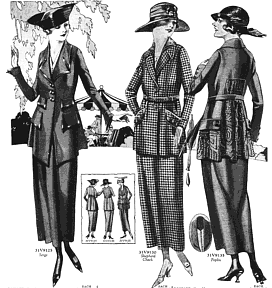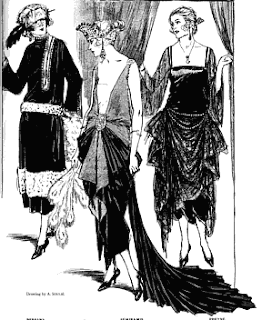Women’s Wardrobe
Women certainly stood out in this wild and stylish era. On August 18, 1920, the Nineteenth Amendment was passed granting women the right to vote. It was the most critical moment in the women’s rights movement. This liberation sparked many other changes in women’s lifestyle. They now flaunted their sexuality freely.
Check out the wonderful women of the 20's!
Check out the wonderful women of the 20's!
Women's clothing had to adapt for practical reasons in order to fit their new lifestyle. With dancing to jazz music every night, came shorter and looser dresses in order to enable the women to swing and dance without restriction. Aside from their parents, no longer was there societal pressure to be conservative with their clothing. They expressed themselves through vibrant coloured silk stockings and dresses that ended just short enough to reveal their knees when they danced. Throughout the decade, corsets became increasingly smaller to allow the women to have more movement in their torso. They eventually became so small that they turned into the modern-day bra.
Contrary to this innovation, the invention of the Symington Side Lacer was introduced. Because the young-boyish look was considered popular and desirable in a woman, women with large busts chose to wear the Symington Side Lacer that had tightening lace on the side, which flattened a woman’s breasts.
 |
| Symington Side Lacer |
 | |
| Late 20's Bra |
This modern woman was called a Flapper.
Templates for 1920's flapper costumes:
 |
| Flappers from 1924-1925 |
 |
| Flappers from 1926-1927 |
 |
| Flappers from 1928-1929 |
Women's Wardrobe Colour Palette:
Men’s Wardrobe
With women’s fashion having been completely redefined, men had to shape up too! No longer were they conservative with their fashion either. Suits became more extravagant yet relaxed. Instead of switching from one stiff, heavy suit to another depending on what time of day it was like they did previous to World War One, they developed a lighter, looser suit (often plaid or tweed) that was acceptable to wear all day long.
Long jackets were only required during formal events allowing men to wear jackets that ended at the hip, which influenced more aesthetic belts to be designed because they were now seen. Due to influence from the wartime uniforms, buttons on the jackets did up much higher. Lapels were thinner and every man’s pocket was filled with a handkerchief. Fat, patterned ties tied the suit together with multiple colours.
Trousers were straight, narrow and short, which allowed more movement during dancing. Because socks were now seen, men became more expressive by choosing bright colours to flash when they performed dance moves that revealed their socks.
Shoes became more colourful and often involved two-tones and fringed tongues. They were lighter weight and more flexible to ensure swift dance moves could be executed.
Hats became all the rage. Trilbies, bowlers, boaters and caps were all used throughout the different times of year and social classes. In the winter, the fedora, trilby and boater were the most popular.
Men's Wardrobe templates:
Men's Wardrobe Colour Palette:
























No comments:
Post a Comment